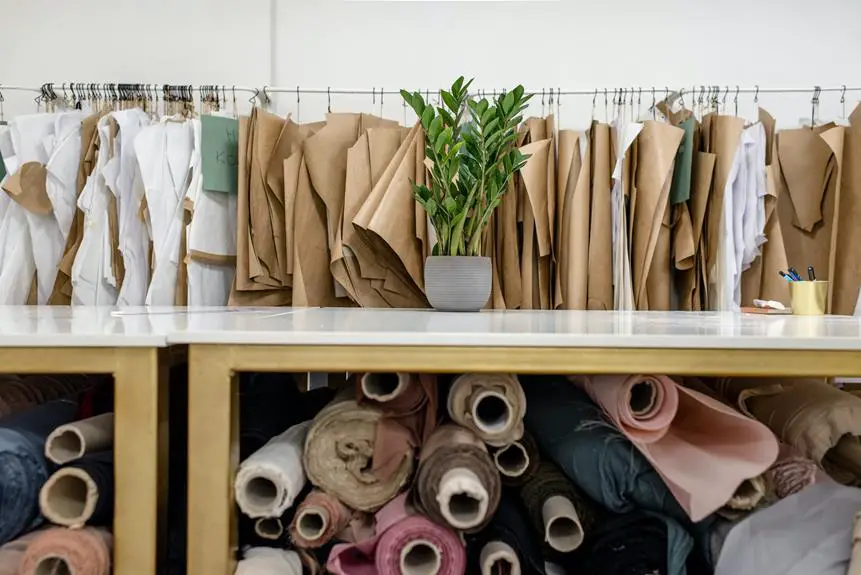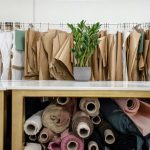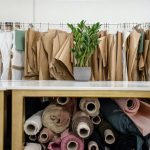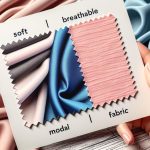When it comes to choosing the perfect fabric for your wardrobe, the decision between modal and rayon can be a tough one. Both offer unique qualities that cater to different needs. Understanding the differences and benefits of each fabric will help you make an informed choice.
In this comparison, we'll delve into the fabric composition, softness and comfort, breathability and moisture management, durability and longevity, versatility and styling options, as well as eco-friendliness and sustainability.
By gaining mastery over these aspects, you'll be able to confidently select the fabric that best suits your preferences and lifestyle. Let's explore the nuances of modal and rayon to determine which fabric emerges as the best choice for you.
Key Takeaways
- Modal fabric is known for its exceptional softness and smooth texture, providing enhanced comfort.
- Modal fabric offers excellent breathability and moisture management, keeping you cool and dry.
- Modal fabric is durable and long-lasting, with a higher wet strength and resistance to pilling and tearing.
- Modal fabric is versatile and stylish, allowing for a wide range of clothing options and unique looks.
Fabric Composition
Choosing between modal and rayon involves considering the fabric composition, which can greatly impact the performance and feel of the clothing you wear.
Modal is a type of rayon made from beech tree fibers, giving it a natural softness and breathability. On the other hand, rayon is a synthetic fabric made from cellulose fibers, often derived from wood pulp.
The differences in fabric composition between modal and rayon result in distinct characteristics. Modal is known for its exceptional softness, smooth texture, and ability to drape well, making it a popular choice for comfortable clothing. Rayon, while also soft, has a slightly different feel and can mimic the texture of natural fibers like cotton, silk, or wool.
Understanding the fabric composition of these textiles is crucial in making an informed decision about which fabric best suits your needs. When making a textile comparison between modal and rayon, considering the fabric composition allows you to choose a fabric that aligns with your preferences for comfort, performance, and overall feel.
Softness and Comfort
Considering the fabric composition discussed earlier, you'll find that modal excels in providing exceptional softness and comfort due to its natural fibers from beech trees. This results in a fabric texture that's incredibly smooth and gentle against the skin, making it a top choice for those who prioritize comfort.
Moreover, modal fabric has excellent temperature control properties, ensuring that you stay cool in hot weather and warm in chilly conditions.
- Silky Smooth Texture: Modal fabric offers a luxurious feel, akin to silk, making it a delight to wear and touch.
- Breathability: The natural fibers of modal enable enhanced breathability, preventing discomfort from excessive sweating.
- Moisture Absorption: Modal is adept at absorbing moisture, keeping you feeling dry and comfortable throughout the day.
- Year-Round Comfort: Its temperature-regulating properties make modal suitable for wearing in any season, ensuring consistent comfort.
With its superior softness, breathability, and temperature control, modal fabric provides an unparalleled level of comfort, making it an ideal choice for various clothing and bedding items.
Breathability and Moisture Management
When it comes to breathability and moisture management, both modal and rayon have their own strengths.
Modal is known for its moisture-wicking properties, making it a great choice for activewear and hot climates.
On the other hand, rayon's breathable fiber structure allows for good airflow, making it a comfortable option for everyday wear.
Modal's Moisture-Wicking Properties
Modal fabric's moisture-wicking properties make it a top choice for those seeking breathable and moisture-managing clothing. The unique characteristics of Modal contribute to its exceptional moisture-wicking benefits, providing a comfortable and soft feel while effectively managing moisture.
Here are some reasons why Modal's moisture-wicking properties stand out:
- Excellent breathability, keeping you cool and dry
- Efficient moisture management, preventing clamminess
- Quick-drying properties, ideal for active wear
- Enhanced comfort, even in humid conditions
These features make Modal an excellent choice for activewear, undergarments, and everyday clothing where moisture-wicking and breathability are essential.
When compared to Rayon, Modal's superior moisture-wicking abilities offer a compelling reason to choose this fabric for your wardrobe.
Rayon's Breathable Fiber Structure
Rayon's breathable fiber structure enables efficient moisture management and superior breathability, making it an excellent choice for various clothing applications.
The breathable fiber structure of rayon allows for air circulation, keeping the body cool and dry.
This makes rayon an ideal fabric for activewear, undergarments, and summer clothing.
The breathability of rayon also contributes to its comfort and softness, providing a pleasant wearing experience in various climates.
Additionally, rayon's moisture management properties help wick away sweat and moisture from the skin, preventing discomfort and promoting a feeling of freshness.
Whether used in casual wear or sportswear, rayon's breathable fiber structure enhances the overall wearing experience, making it a preferred choice for those seeking comfort, softness, and effective moisture management in their clothing.
Durability and Longevity
When it comes to choosing between modal and rayon, it's important to consider the durability and longevity of the fabrics. Understanding the strength and resilience of each material will help you make an informed decision about which one is the best choice for your needs.
Let's explore the factors that contribute to the durability of modal and rayon to help you make a confident choice.
Modal Vs Rayon: Strength
When considering strength, durability, and longevity, the choice between modal and rayon fabric is an important factor to keep in mind.
Modal fabric is known for its exceptional strength, making it less prone to pilling and tearing compared to rayon.
On the other hand, rayon fabric is recognized for its durability, as it can withstand regular wear and washing without losing its shape or color.
When comparing the two fabrics for strength, it's essential to consider factors such as:
- Modal's resistance to pilling and tearing
- Rayon's ability to maintain shape and color after washing
- Modal's strength and ability to withstand frequent use
- Rayon's durability and resilience against wear and tear
Understanding the specific strengths of each fabric can help you make an informed choice based on your needs and preferences.
Durability: Modal Vs Rayon
Considering the durability and longevity of modal and rayon fabrics, you'll find that both offer distinct advantages in terms of wear and resilience.
Modal, derived from beech trees, is known for its strength and resistance to pilling, making it more durable compared to traditional rayon. It also has a higher wet strength, meaning it retains its shape better when wet, making it a great choice for clothing that requires frequent washing.
Rayon, on the other hand, is less resistant to wrinkling compared to modal, but with proper care and maintenance, it can still provide good durability.
To prolong the life of both fabrics, it's essential to follow specific maintenance tips such as gentle washing, avoiding high heat when drying, and storing garments properly to prevent stretching or misshaping.
Versatility and Styling Options
Choose modal for a wide range of versatile and stylish options. Modal fabric offers a plethora of styling options, making it a versatile choice for various fashion trends and personal preferences.
Here are some reasons why modal is the best choice for those seeking versatility and style:
- Drapes Beautifully: Modal fabric has excellent drape and flow, making it perfect for creating elegant and flowing garments.
- Versatile Coloring: Modal fabric takes dye easily, resulting in vibrant and long-lasting colors, allowing for a wide range of styling and color options.
- Mix and Match: Modal blends well with other fabrics, allowing for unique texture combinations and versatile garment designs.
- Casual to Formal: From casual wear to formal attire, modal fabric adapts to various styles, making it suitable for a wide range of occasions.
With these versatile and stylish options, modal fabric stands out as a top choice for those who value flexibility and fashion-forward choices in their clothing. Whether you're following the latest fashion trends or expressing your personal style, modal fabric offers endless possibilities for creating unique and stylish looks.
Eco-Friendliness and Sustainability
For an eco-friendly and sustainable option, modal fabric is an excellent choice due to its minimal environmental impact and renewable sourcing. Modal is produced from beech trees, a replenishable raw material, and the production process is eco-friendly, using closed-loop systems that minimize waste and emissions. In contrast, rayon, although derived from natural sources like wood pulp, often involves more environmentally harmful production methods. The table below illustrates the eco-friendly production and sustainable sourcing of modal fabric compared to rayon.
| Modal Fabric | Rayon Fabric | |
|---|---|---|
| Eco-Friendly Production | Modal is manufactured through a closed-loop process that recycles solvents and minimizes waste. | Rayon production involves more extensive use of chemicals and water, leading to greater environmental impact. |
| Sustainable Sourcing | Modal is made from beech trees, which are a renewable resource requiring minimal water and no chemical fertilizers. | Rayon is derived from wood pulp, but the production may involve deforestation and use of non-renewable resources. |
Frequently Asked Questions
Can Modal and Rayon Fabrics Be Easily Dyed or Printed With Patterns?
Yes, both modal and rayon fabrics can be easily dyed with vibrant colors and printed with intricate patterns. The dyeing process allows for rich, even color absorption, and the printing maintains excellent colorfastness.
Are There Any Special Care Instructions for Maintaining the Quality of Modal and Rayon Fabrics?
To maintain the quality of modal and rayon fabrics, special care is needed. Follow specific instructions for washing and drying. Avoid harsh chemicals and high heat. When dyeing or printing patterns, use techniques suitable for delicate fabrics.
How Do Modal and Rayon Fabrics Compare in Terms of Shrinkage and Stretching?
When comparing modal and rayon fabrics for shrinkage and stretching, consider that both can shrink if not cared for properly. Modal has better stretching recovery, making it ideal for dyeing and printing.
Are There Any Specific Uses or Applications Where Modal Fabric Would Be Preferred Over Rayon, or Vice Versa?
When considering specific uses or applications, understanding the differences between modal and rayon is crucial. While both fabrics have similarities, such as being derived from cellulose, modal is preferred for its high wet strength and softness, making it ideal for intimate apparel and activewear.
What Are the Potential Environmental Impacts of Producing Modal and Rayon Fabrics, and How Do They Differ in Terms of Sustainability?
When considering the environmental impacts of producing modal and rayon fabrics, it's important to note that modal is often considered more sustainable due to its production process using beech trees and closed-loop systems. Sustainability comparison reveals modal as a preferred choice.
- How Nonwoven Technology Revolutionized the Diaper Industry - July 11, 2025
- A Guide to Nonwoven Fabric Weights (GSM) and Their Meanings - July 11, 2025
- The Technology Behind Airlaid Nonwoven Production - July 11, 2025






